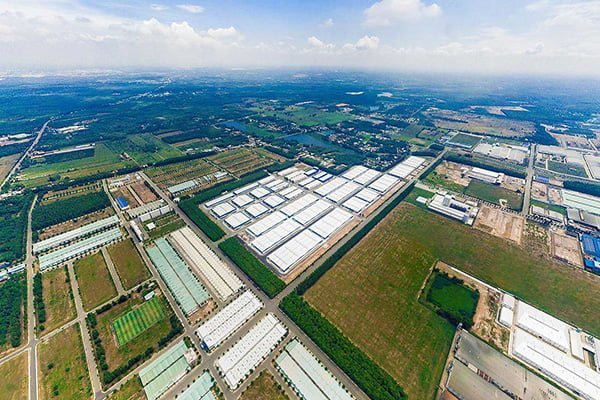With the primary aim of facilitating export-oriented manufacturing and trade, Vietnam’s export processing enterprises enjoy a host of benefits, including tax exemptions, simplified customs procedures, and streamlined regulations. These collective benefits foster an investor-friendly environment, enticing entrepreneurs to establish and operate their businesses within this framework.
Furthermore, amidst the concurrent challenges posed by the US-China trade war and the COVID-19 pandemic, businesses are compelled to diversify their supplier sources and explore alternative production methods as part of their long-term strategies. Consequently, there has been a surge in the popularity of export processing enterprises among investors, with Vietnam emerging as an ideal destination for such ventures.
What is an export processing enterprise?
An export processing enterprise (EPE) is officially defined at Decree No.35/2022/ND-CP as an enterprise engaging in manufacturing goods for export and providing services related to the production and exportation of goods within designated areas such as export processing zones, industrial parks, and economic zones.
The site locations are required by laws to have distinct separation using fence systems, entrance and exit doors, and adherence to the regulations for non-tariff zones to ensure effective supervision and control by customs authorities and other relevant agencies. Hence, it is crucial for investors to thoroughly check if the locations they are considering meet the mentioned requirements.
Eligible locations
Export Processing Zones (EPZs)
According to No.35/2022/ND-CP, EPZs refers to an industrial park specially intended for manufacturing of exported goods, rendering of services meeting the needs of production of exported goods and exporting purposes, which is fenced in under the regulatory provisions applied to the free zones stipulated in law on customs duties.
As of now, Vietnam has only four EPZs, all located in the Southern Key Economic Region.
- Tan Thuan Export Processing Zone
Established in 1992, Tan Thuan EPZ is the first Export Processing Zone (EPZ) in the region. Tan Thuan EPZ is home to many industries, encompassing textiles, yarns, garments, high-tech software, electric appliances, electronics, precision machinery, and mechanical sectors.
At the moment, Tan Thuan EPZ boasts an impressive occupancy rate of over 95% with more than 200 investors from 22 countries, including prominent players like Sanyo Semiconductor Co., Ltd, Toyo Precision Co., Ltd, and Nidec Tosok Corporation.
- Linh Trung I, II, III Export Processing Zone:
Linh Trung Export Processing Zone (EPZ) is a joint venture between Vietnam and China, spearheaded by Tan Thuan Industrial Promotion Company Limited and China Electric Export-Import Co., Ltd. This expansive industrial complex is divided into three phases: Linh Trung I, Linh Trung II, and Linh Trung III. The EPZ focus encompasses various industries, including mechanical engineering, electronics, chemicals, high-tech, and supporting sectors.
As of the present, Linh Trung I and II have reached full capacity, hosting more than 60 projects primarily driven by investors from Hong Kong, Taiwan, South Korea, and Japan. Meanwhile, Linh Trung III is actively attracting investors, with a significant influx from China, South Korea, Japan.
Notable investors within Linh Trung EPZ include Nisei Electric Vietnam, Kachiboshi Vietnam Co., Ltd, Freetrend Industrial A Co., Ltd, Katagiri Industry Vietnam Co., Ltd, and Hansea Vietnam Co., Ltd.
Industrial parks (IPs)
EPEs can also be located in IPs along with other manufacturing businesses, provided they meet the requisite facilities’ standards. As of 2022, Vietnam boasts a total of 563 IPs distributed across 61 out of its 63 provinces. Among these, 397 IPs have been established, with 106 IPs in various stages of construction. The Vietnamese Real Estate Report for 2022 reveals that 292 IPs are fully operational, indicating a robust infrastructure for industrial development. See more information at A Guide to Vietnam’s Industrial Parks
Economic Zones (EZs)
According to Decree No. 35/2022/ND-CP, an EZ is a defined geographical area comprising multiple functional zones established to achieve objectives of attracting investment, socioeconomic development, and safeguarding national defense and security.
Specifically, EZs are classified into 3 types:
- Coastal Economic Zone: Established in coastal areas and adjacent areas near the coast, such as Dinh Vu – Cat Hai EZ (Hai Phong), Nghi Son EZ (Thanh Hoa), Chu Lai EZ (Quang Nam), and more.
- Border Gate Economic Zone: Established in inland border areas and adjacent areas near the inland border, such as Mong Cai EZ (Quang Ninh), Dong Dang – Lang Son EZ (Lang Son), Lao Cai EZ (Lao Cai), among others.
- Specialized Economic Zone: Established in key economic zones, development corridors, dynamic development areas, or areas with similar roles as identified in regional planning, including Phu Quoc EZ (Kien Giang), Van Don EZ (Quang Ninh), and Bac Van Phong (Khanh Hoa).
EPEs can be located in industrial zones within these EZs to enjoy great tax benefits, while complying to the facilities and customs requirements.
Tax incentives for an EPE
Similar to a non-EPE, an EPE is granted corporate income tax (CIT) incentives and land rental incentives based on their business line and location. These incentives encompass preferential tax rates, tax exemptions, and tax holidays. The crucial distinction, however, lies in the incentives related to customs duties and value-added tax.
Table 1– Value-added tax (VAT) and duties incentives for EPEs

Navigating Vietnam’s export processing enterprises requires a comprehensive understanding of the regulatory landscape, site requirements, tax incentives, and establishment procedures. With its strategic advantages and conducive business environment, Vietnam presents lucrative opportunities for investors seeking to engage in export-oriented manufacturing and trade through the EPE model.



